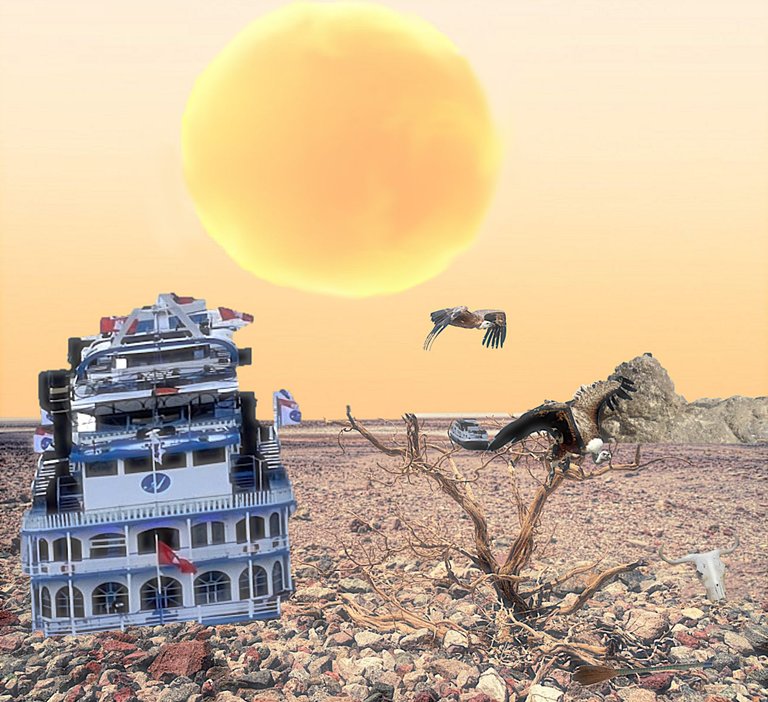
When I saw the template photo this week (by @shaka) for LMAC Collage Contest #216, I was struck by the amount of human activity evident in the port.
Template
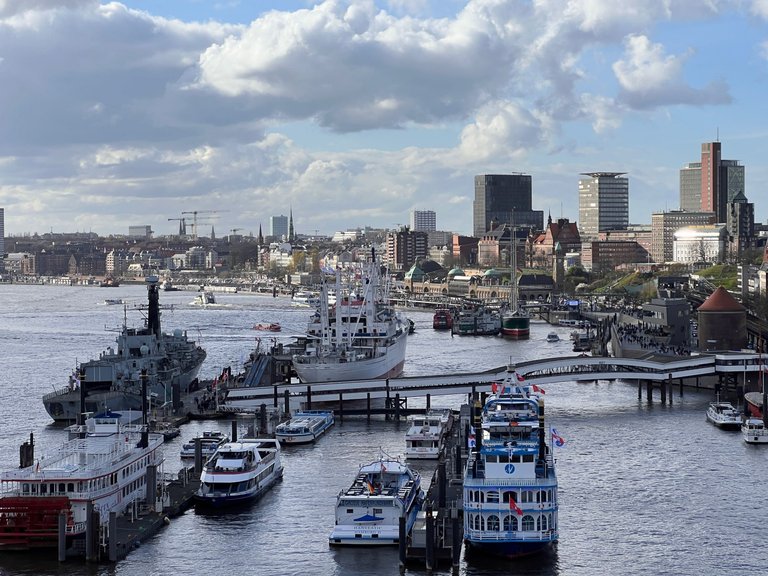
There was nothing I was move to do with that template, artistically, except to get rid of so much of what I saw. And then I imagined the place empty, and my collage slowly came into place--the consequence, perhaps of too much human intrusion into the environment. The subject of my blog followed naturally.
Water, an Increasingly Scarce Resource
Last week I was doing my bedtime reading on my iPad when I came across a startling bit of information: The earth may be experiencing, right now, its sixth mass extinction event.
Some scientists believe that the current mass extinction event began 10,000 years ago, as humans started molding earth to their needs. There are other scientists who refer to this sixth mass extinction more in future terms. One article I read suggested we might reach mass extinction in the next 240-540 years.
The five past mass extinction events had several characteristics in common, according to the website Our World Data:
There’s a natural background rate to the timing and frequency of extinctions: 10% of species are lost every million years, 30% every 10 million years, and 65% every 100 million years.
These extinction events were part of a natural evolutionary process. Species died off and others evolved to replace them. The current extinction event is the first time such event was anthropogenic in origin--caused by human activity. The present mass extinction event is happening much faster than expected.
Cotton Harvest in Xinjiang
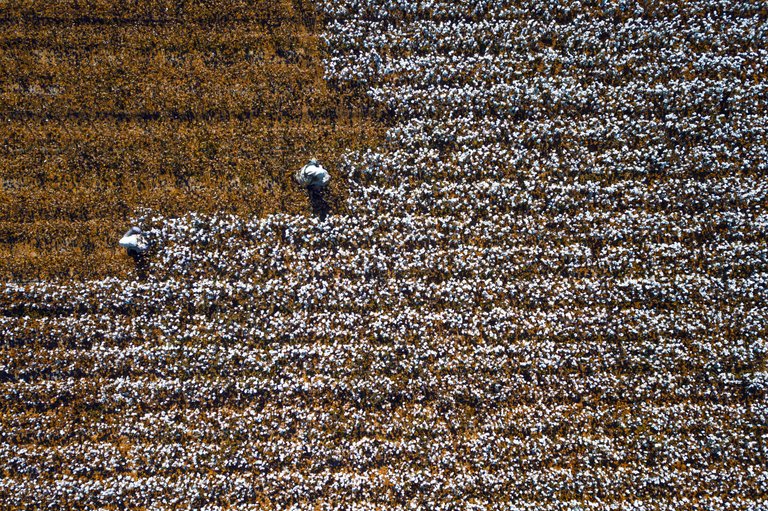
Credit: Azonesa. Used under CC 4.0 Attribution-Share Alike International License. Cotton cultivation degrades soil. World Wildlife Fund, explains, "Cotton’s most prominent environmental impacts result from the use of agrochemicals (especially pesticides), the consumption of water, and the conversion of habitat to agricultural use".
According to the World Wildlife Fund, the current human influence on land, water, energy, and climate is unsustainable, and this unsustainable change began with the rise of agriculture. The WWF explains that 40% of the land on earth today is devoted to agricultural use. 70% of freshwater use, according to the WWF is dedicated to agriculture and 90% of global deforestation is attributable to agriculture.
With the destruction and/or conversion of land, water and forest, species that inhabit those places are displaced. The WWF further indicts human activity for the acceleration of climate change. This effect is due to greenhouse gas emissions and our methods of food production/use.
The WWF asserts that when human activity decimates other species, it also erodes the earth's ability to sustain human existence on the planet.

The Aral Sea

Credit: Arian Zwegers. Used under CC Attribution Share alike license. Caption under the picture reads:"Derelict ships at the Moynaq ship graveyard, on what was once the bed of the Aral Sea."
(Information derived from an article in Britannica, "Six Lakes that Are Drying Up")
The Aral Sea was once the fourth largest body of water in the world. It has shrunk to a fragment of its former self. According to the Encyclopedia Britannica, the near demise of the sea was due to Soviet Union's water practices--essentially irrigation. The two main sources of water for the sea, Syr Darya River and the Amu Darya River were diverted and could no longer replenish the Aral Sea.
With the loss of its major water source, the Aral Sea became so highly salinated that the fish were killed off, and with that the fishing industry. The water was no longer suitable for drinking.
Lake Poopó, Bolivia
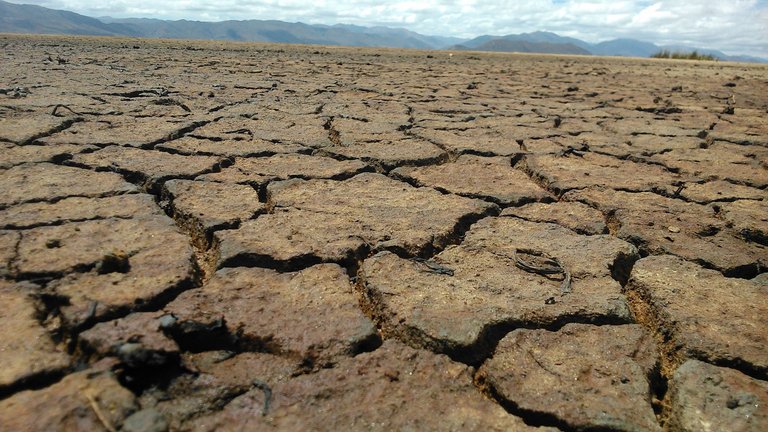
Credit: Chiliguanca. Used under CC 4.0 Attribution Share alike international license.
(Information derived from an article in Britannica, "Six Lakes that Are Drying Up")
Lake Poopó was at one time Bolivia's second largest lake. It was fed from precipitation and the waters of the Desaguadero River. It had no outflow, except through evaporation and ground seepage. The lake was never very deep--8 to 10 feet, but it was about 56 miles long and 20 miles wide.
As can be seen in the picture above, the lake has virtually dried up. Causes of this desiccation were several. The Desaguadero River was diverted for irrigation and to support mining activity. Also, a warming climate tripled the rate of evaporation, and shortened the rainy season.
The reduced inflow and increased loss of water led to the destruction of the lake. This had a catastrophic effect on more than 200 species and on the local indigenous community.
Lackawanna River, USA
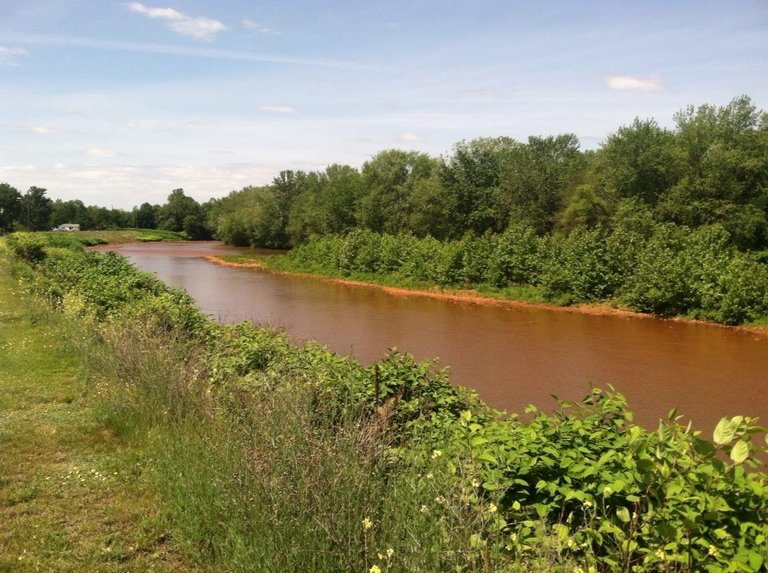
Credit: Josh Felter. Used under CC 4.0 Attribution-share alike 4.0 International license.
Pennsylvania, in the U.S., has more abandoned mines than any other state in the country. Coal mining has been a key element in the Pennsylvania economy since the mid 1800s. The legacy of that industry is contaminated land and polluted waters.
An environmental advocacy organization, Join the River Coalition, outlines the environmental impact of deep shaft mining: There is destruction of the land in order to dig the mine; There is air pollution and there are greenhouse gas emissions; There is additionally the issue of subsidence--the ground above abandoned mines can collapse, and pull everything above in into the pit.
One of the most enduring legacies of deep shaft mining is water pollution, as illustrated by the Lackawanna River picture (above).
Mines use great quantities of water. An organization called the World Resource Institute explains why:
Most methods used to mine critical minerals today require significant amounts of water for separating minerals, cooling machinery and controlling dust
Also, deep shaft mines often are dug below the water table, and therefore can be flooded unless the water is pumped out.
In the case of the Lackawanna River, the U.S. Army Core of Engineers has drilled a large bore hole in northern Pennsylvania to drain water from an abandoned mine. Pumps from the bore hole send approximate 100-150 million gallons of water every day into the Lackawanna. This is done to relieve the potential for flooding in surrounding Pennsylvania communities. The Lackawanna River turns orange because of the chemical compounds--iron oxide, sulfur, aluminum and manganese--that dissolve in the water. These compounds are "detrimental to aquatic life* (!).

My Collage
I borrowed heavily from Pixabay to make the collage, and also borrowed from my friends at LMAC (LIL Gallery), @muelli and @yaziris.
Death Valley
https://pixabay.com/sv/photos/death-valley-landskap-buske-kvast-4254872/
Broom
@yaziris
https://www.lmac.gallery/lil-gallery-image/7638
Rock
@muelli
https://www.lmac.gallery/lil-gallery-image/6173
Sky Namibia
https://pixabay.com/sv/photos/namibia-afrika-%C3%B6ken-natur-sahara-4965456/
Vulture
https://pixabay.com/sv/photos/f%C3%A5gel-rovf%C3%A5glar-natur-3151420/
Skull
https://pixabay.com/sv/photos/%C3%A5ra-d%C3%B6tt-djur-kadaver-577763/
Vulture flying
https://pixabay.com/sv/photos/gam-flyga-mark-raptor-f%C3%A5gel-2785815/
Sun
https://pixabay.com/sv/photos/solnedg%C3%A5ng-sol-himmel-moln-orange-2180346/
It took a few tries to get the picture right. At one point I had to scrap it and start over, but it was worth the effort. The result is exactly what I was going for.
This is the one I scrapped:
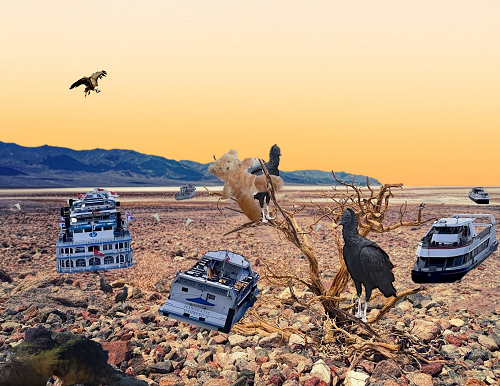
(Teddy Bear in the tree was from the LIL Gallery, Credit @yaziris)
LIL is not only a valuable image resource for the Hive community, but is also a way for community members to participate in LMAC. Anyone on Hive can contribute to the library and everyone can borrow from it. Learn about the procedure here.
Every week we offer prizes to fifteen finalists in the contest, but it's not only the prizes people create for. I personally spend hours giving vent to my imagination, although I don't compete in the contest. Others in the community have developed the habit of 'speaking' through collage.
This week's contest has concluded. A new contest will begin on Thursday, with a brand new template. Please join in the fun.
As @shaka has said many times, everyone is an artist. I may not be an artist in the technical sense, but LMAC allows me to nurture my own unique artistic voice.
Thank you for reading. Peace and health to all.






